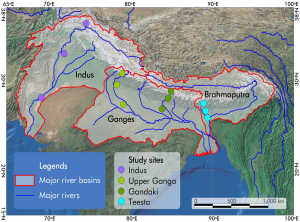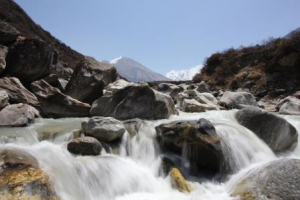The project prepares robust climate mitigation and adaptation pipelines aligned with the Paris Agreement and responsive to DMCs climate change priorities. The TA will support interventions on departmental, sectoral and country levels with key activities including development of a regional strategy, upstream climate assessments, climate pipeline development, government dialogues and capacity building. As part of this project, FutureWater conducts a regional climate risk assessment for ten countries. This includes an assessment of baseline and future climate hazards, exposure and vulnerability and addressing sectoral impacts and adaptation options for a wide range of sectors. In addition country profiles summarizing climate risks for the ten countries are generated. The reginal climate risk assessment feeds into the climate strategy.
Agriculture is the most water demanding and consuming sector, globally responsible for most of the human induced water withdrawals. This abstraction of water is a critical input for agricultural production and plays an important role in food security as irrigated agriculture represents about 20 percent of the total cultivated land while contributing by 40 percent of the total food produced worldwide.
The FAO Regional Office for Asia and the Pacific (FAO-RAP) is concerned about this increase in water use over the last decades that has led to water scarcity in many countries. This trend will continue as the gap between water demand and supply is projected to widen due to factors such as population growth and economic development, and environmental factors such as land degradation and climate change.
Unfortunately, solutions to overcome the current and future water crisis by looking at the agricultural sector are not simple and have often led to unrealistic expectations. Misconceptions and overly simplistic (and often erroneous) views have been flagged and described over the last recent decades. However, uptake of those new insights by decision makers and the irrigation sector itself has been limited.
The “Follow the Water” project will develop a Guidance Document that summarizes those aspects and, more importantly, quantifies the return flows that occurs in irrigated systems. Those return flows are collected from a wide range of experiments and are collected in a database to be used as reference for new and/or rehabilitation irrigation projects.
The FAO/FutureWater project will also develop a simple-to-use tool to track water in irrigated systems using so-called “virtual tracers”. The tool will respond to the demand for a better understanding the role of reuse of water in irrigated agriculture systems. An extensive training package, based on the Guidance and the Tool, is developed as well.
FAO plays an essential role in backstopping the development of the Guidance and the Tool and promoting. FutureWater takes the lead in development of the Guidance, the Tool and the training package. With this, FAO and FutureWater will contribute to a sustainable future of our water resources.
In irrigated agriculture options to save water tend to focus on improved irrigation techniques such as drip and sprinkler irrigation. These irrigation techniques are promoted as legitimate means of increasing water efficiency and “saving water” for other uses (such as domestic use and the environment). However, a growing body of evidence, including a key report by FAO (Perry and Steduto, 2017) shows that in most cases, water “savings” at field scale translate into an increase in water consumption at system and basin scale. Yet despite the growing and irrefutable body of evidence, false “water savings” technologies continue to be promoted, subsidized and implemented as a solution to water scarcity in agriculture.
The goal is to stop false “water savings” technologies to be promoted, subsidized and implemented. To achieve this, it is important to quantify the hydrologic impacts of any new investment or policy in the water sector. Normally, irrigation engineers and planners are trained to look at field scale efficiencies or irrigation system efficiencies at the most. Also, many of the tools used by irrigation engineers are field scale oriented (e.g. FAO AquaCrop model). The serious consequences of these actions are to worsen water scarcity, increase vulnerability to drought, and threaten food security.
There is an urgent need to develop simple and pragmatic tools that can evaluate the impact of field scale crop-water interventions at larger scales (e.g. irrigation systems and basins). Although basin scale hydrological models exist, many of these are either overly complex and unable to be used by practitioners, or not specifically designed for the upscaling from field interventions to basin scale impacts. Moreover, achieving results from the widely-used FAO models such as AquaCrop into a basin-wide impact model is time-consuming, complex and expensive. Therefore, FutureWater developed a simple but robust tool to enhance usability and reach, transparency, transferability in data input and output. The tool is based on proven concepts of water productivity, water accounting and the appropriate water terminology, as promoted by FAO globally (FAO, 2013). Hence, the water use is separated in consumptive use, non-consumptive use, and change in storage.
A complete training package was developed which includes a training manual and an inventory of possible field level interventions. The training manual includes the following aspects:
- Introduce and present the real water savings tool
- Describe the theory underlying the tool and demonstrating some typical applications
- Learn how-to prepare the data required for the tool for your own area of interest
- Learn when real water savings occur at system and basin scale with field interventions
The SREB is part of the Belt and Road Initiative, being a development strategy that focuses on connectivity and cooperation between Eurasian countries. Essentially, the SREB includes countries situated on the original Silk Road through Central Asia, West Asia, the Middle East, and Europe. The initiative calls for the integration of the region into a cohesive economic area through building infrastructure, increasing cultural exchanges, and broadening trade. A major part of the SREB traverses Asia’s high-altitude areas, also referred to as the Third Pole or the Asian Water Tower. In the light of the planned development for the SREB traversing the Third Pole and its immediate surroundings, the “Pan-Third Pole Environment study for a Green Silk Road (Pan-TPE)” program will be implemented.
The project will assess the state and fate of water resources in the region under following research themes:
1. Observed and projected Pan-TPE climate change
2. Impacts on the present and future Water Tower of Asia
3. The Green Silk Road and changes in water demand
4. Adaptation for green development
 HI-AWARE is one of four consortia of the Collaborative Adaptation Research Initiative in Africa and Asia (CARIAA). HI-AWARE aims to contribute to enhanced adaptive capacities and climate resilience of the poor and vulnerable women, men, and children living in the mountains and flood plains of the Indus, Ganges, and Brahmaputra river basins through the development of robust evidence to inform people-centred and gender-inclusive climate change adaptation policies and practices for improving livelihoods.
HI-AWARE is one of four consortia of the Collaborative Adaptation Research Initiative in Africa and Asia (CARIAA). HI-AWARE aims to contribute to enhanced adaptive capacities and climate resilience of the poor and vulnerable women, men, and children living in the mountains and flood plains of the Indus, Ganges, and Brahmaputra river basins through the development of robust evidence to inform people-centred and gender-inclusive climate change adaptation policies and practices for improving livelihoods.
HI-AWARE will:
- Generate scientific knowledge on the biophysical, socio-economic, gender, and governance conditions and drivers leading to vulnerability to climate change;
- Develop robust evidence to improve understanding of the potential of adaptation approaches and practices, with an explicit focus on gender and livelihoods;
- Develop stakeholder-driven adaptation pathways based on the up- and out-scaling of institutional and on-the-ground adaptation innovations;
- Promote the uptake of knowledge and adaptation practices at various scales by decision-makers and citizens; and
- Strengthening the interdisciplinary expertise of researchers, students, and related science-policy-stakeholder networks.

HI-AWARE will focus its activities in 12 sites, representing a range of climates, altitudes, hydro-meteorological conditions, rural-urban continuum, and socio-economic contexts in four study basins: the Indus, Upper Ganga, Gandaki and Teesta. It will conduct research in these sites, including modeling, scoping studies, action research, and randomized control trials. It will test promising adaptation measures in observatory labs at the sites for out-scaling and up-scaling. It will also conduct participatory monitoring and assessment of climate change impacts and adaptation practices to identify:
- Critical moments – times of the year when specific climate risks are highest and when specific adaptation interventions are most effective;
- Adaptation turning points – adaptation turning points – when current policies and management practices are no longer effective and alternative strategies have to be considered; and
- Adaptation pathways – sequences of policy actions that respond to adaptation turning points by addressing both short term responses to climate change and longer term planning.

FutureWater’s main tasks focus on biophysical drivers and conditions leading to vulnerability to climate change. Key tasks are to:
- Develop detailed mountain specific and basin scale climate change scenarios;
- Improve cryosphere-hydrological modeling to assess significant shifts in flow regimes with an aim to develop water demand and supply scenarios as well as improve and apply water-food impact models; and
- Better understand climate change impacts on extremes (heat, floods, drought),and quantify these extremes from climate models and subsequently impact models.
The Indus basin is a densely populated area and water supplied by the Indus River is extremely important for agriculture, domestic use and hydropower production. The Indus is largely dependent on melt water generated in the Himalayas, Karakoram and Hindu Kush mountains. Understanding of the hydrological regimes in the mountainous Upper Indus basin (UIB) is essential for water resources management in the region.
It is highly likely that future climate change will impact future water availability in the Upper Indus river basin. Temperature increases and changes in the timing, magnitude, and phase of precipitation will alter the timing and contribution of snow and ice melt.
High-resolution gridded meteorological datasets, which capture the spatial variability of precipitation, are critical for modelling the hydrology of high-mountain regions. In the Upper Indus Basin (UIB), previous modelling studies have demonstrated that snow and glacier melt are major contributors to stream discharge, and on daily or seasonal scales can play even larger roles. However, hydrologic models suffer from a lack of gridded input climate data which accurately reflects the topographic complexity and spatial variability in precipitation. Improvements to existing gridded datasets using high-elevation station data will increase the reliability of hydrological models in the region. FutureWater’s Spatial Processes in Hydrology (SPHY) model will be updated and recalibrated to improve understanding of the stream flow composition in the basin and to provide better estimates of the future water availability, by forcing the model with downscaled CMIP5 general circulation models.
Summarizing, the three main goals of the project are:
- To develop a high-quality meteorological forcing dataset (temperature and precipitation) for the UIB by merging existing gridded datasets and high-altitude climate observations.
- To improve the existing large-scale SPHY model by including a reservoir scheme and recalibrating the model with additional observations (geodetic mass balance, time series of river runoff, time series of reservoir inflow data).
- To use the recalibrated SPHY model to examine shifts in the basin hydrology under CMIP5 climate change scenarios.
